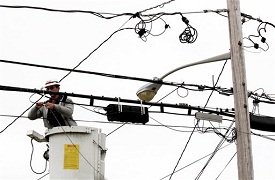| Home | Blog | Ask This | Showcase | Commentary | Comments | About Us | Contributors | Contact Us |

Please, sir, may I have another?ASK THIS | April 109, 2012The nation's major telecom companies have been ripping us off blind for 20 years, writes customer advocate Bruce Kushnick. And now they want to weasel out of their obligation to provide affordable telephone service to homes? By Bruce Kushnick (First in a three-part series.) For the last 20 years, the nation's major telecom companies have been playing the public and regulatory officials for fools -- wangling dramatic rate increases while making promises about fiber-optic cable they haven't delivered; pleading poverty even as they rack up record profits. Now they're claiming they shouldn't be obliged to provide affordable landline service to everyone anymore, as they take the money and run to wireless. New Networks Institute just put out a new report this week: "Verizon’s State-Based Financial Issues & Tax Losses: The Destruction of America’s Telecommunications Utilities, the Public Switched Telephone Networks (PSTN).” Here are the top four things you should know about our latest findings:
A little background: Starting with the Telecommunication Act of 1934, 78 years ago, every phone company was required to put a wire into every home, business, school library, etc., at "fair and reasonable rates". Each state has one or more phone utility to provide that state with phone service. The Public Switched Telephone Networks (PSTN) was a term to show that the networks had "public" responsibilities. And it encompassed everything that went over the wires -- all services, broadband internet or phone, not to mention all buildings, poles, etc. Verizon’s state-based companies are the old Bell companies’ phone networks, such as New York Telephone or Pacific Bell. And here are some of the questions reporters should be asking: Q. How much has Verizon collected in rate hikes in order to upgrade the old, copper telephone wires to fiber optic? In the 1992 presidential campaign, then-senator Al Gore proposed that America’s communications be rewired with fiber optics, and he dubbed it the Information Superhighway. Verizon and AT&T jumped in and said they’d rewire their entire territories with a completion date of 2010. They went state-to state to get changes in state laws, known as "alternative regulations", that gave them excess profits to use the money for construction to give 45 megabytes per second (Mbps) services in both directions to everyone. While every state is different, Pacific Bell of California stated they would spend $16 billion by 2000 on 5.5 million homes. Bell Atlantic claimed it would spend $11 billion on 8.75 million homes. Verizon New Jersey claimed it would have 100 percent of the state completed by 2010 with 45 Mbps; Massachusetts was to have 330,000 lines by 2000. None of these commitments were met, even though the companies collected billions per state. We estimate that in New Jersey alone, Verizon collected over $13 billion in excess profits and tax breaks, while putting down only enough cable to serve an estimated 57 percent of the households in its territories. Nationally, Verizon’s FiOS fiber optic cable service only passes 50 percent of their homes. (Their numbers are higher as they don’t bother to include the fact that since their original announcements they sold off Maine, New Hampshire, Vermont and some of their other more rural properties throughout the U.S.) And Verizon recently announced it is no longer expanding its network. AT&T’s U-Verse, which is AT&T’s cable broadband service isn’t even fiber optic to the home but uses the old copper wiring. This new AT&T controls 22 states, including California, Texas, Illinois and most of Connecticut. AT&T has also announced that it was stopped expanding U-Verse deployments. Combined, AT&T and Verizon only have 8 million cable-TV upgraded homes – out of 120 million total households. Q. So does that mean customers whose phone rates went up for 20 years -- expecting their phone service to be upgraded to broadband -- instead paid for a private cable service that's not being deployed to 50 percent of those who paid for it? Yes. Perhaps more importantly, even, if customers paid for 45 Mbps services in both directions, where is it? U-Verse is AT&T's cable service, and its premium package's top speed is 24 Mbps in one direction. Instead, the companies pulled one of the largest bait-and-switches in history when they rolled out DSL over the old copper wiring. Customers paid for a Ferrari on the information superhighway, but got an expensive dirt bike. Q. How can parts of Verizon be showing huge losses when we all know Verizon is making big profits? Over the last two decades, Verizon created multiple "affiliates", including Verizon Wireless, Verizon Online, Verizon Long Distance, and Verizon Business, among others. And it seems that these companies are eating the wireline utilities alive. The losses appear to be caused by the national affiliates shortchanging the utilities by not paying a fair share for services they use, dumping their expenses into the utility, and putting the revenues into different buckets. One of the largest areas of expense dumping has been Verizon Services, which is the corporate parent that includes “corporate governance, corporate finance, external affairs, legal, media relations, employee communications, corporate advertising.” The end result is that rate increases at the state level have been funding such things as lobbying, executive pay, and PR. There is also evidence that Verizon Wireless is underpaying its wireline subsidiaries for its use of the wires connecting cell towers. Meanwhile, Verizon New Jersey claims that they are moving construction budgets from wireline to wireless --- which would mean that the regular phone customers are now funding the wireless division – a move that is illegal in some states. In conclusion: The caretakers of America's essential infrastructure have scammed us, big time, and it’s going to get worse. Right now Verizon and AT&T not only aren’t upgrading the existing phone network, they’ve stopped expanding FiOS and U-Verse, even though they keep getting money for these upgrades. Every municipality and every person in those municipalities that were never upgraded should be up in arms. NEXT: Why relying on wireless services instead of building infrastructure will harm customers and the economy.
|
||||||||||||




